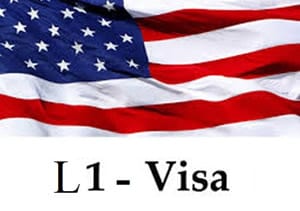
The L-1 visa permits U.S. employers that have a qualifying relationship with a company abroad to transfer employees in managerial, executive or specialized knowledge roles to the U.S. The employee must have worked for the company abroad for at least one year of out the past three years in a managerial, executive or specialized knowledge role. The L-1 visa also enables a foreign company which does not yet have an affiliated U.S. office to send a specialized knowledge employee or a managerial or executive employee to the United States to set one up.
Below are some frequently asked questions about the L-1 visa:
What counts as a qualifying relationship between companies?
A company is considered to have a qualifying relationship sufficient to sponsor an L-1 visa when the company is either a parent, branch, affiliate or subsidiary of a foreign firm operating abroad. This means that it is not always necessary to incorporate a U.S. company to qualify for the L-1 visa, as a foreign company may send employees to work at a branch office located in the U.S.
If I want to open a new office in the U.S., how do I show the U.S. company is doing business?
The following documents can help meet this requirement: Comprehensive Business plan,Signed office lease with description of premises and square footage & photos of the premises, Proof of all assets which have been purchased for use in the U.S. enterprise, Business bank account set up information, Evidence of capital contributions, & Advertisement material/brochures/business cards.You can learn more about L-1 new office applications by clicking here and here.
What documents must be submitted to prove that the employee worked for the company abroad for at least one year out of the past three years?
You should submit an employment letter from your manager, a letter from Human Resources & your paystubs showing the length of time that you have been working for the company. You may also submit your foreign tax returns. If you own the company and you are not on payroll but you take distributions or have some other compensation arrangement, you can provide evidence of this arrangement.
What is the difference between an L-1A and L-1B visa?
An L-1A visa is for employees who are coming to the U.S. to hold managerial or executive roles. The L-1B visa is for employees who are coming to the U.S. to hold specialized knowledge roles.
How do I prove I worked in an executive, managerial or specialized knowledge role?
You should submit an employment letter from your supervisor that provides significant detail about your activities to demonstrate that you are primarily engaged in executive, managerial or specialized knowledge tasks. You may also submit organizational charts to show your place in the hierarchy of the organization and evidence of work product that demonstrates you meet the definition of a manager, executive or specialized knowledge worker.
Can I qualify for an L-1 if I am the owner of the company abroad?
Yes, business owners can qualify for L-1 visas. However, if an owner or a major stockholder of the company is seeking the L-1 visa, the petition must include evidence that the owner’s services are to be used for a temporary period, and that they will be transferred back to the company abroad.
How long can an L-1 visa be granted for?
The L-1A visa can be granted initially for 3 years and can be renewed up to 7 years total. The L-1B visa can be granted initially for 3 years and can be renewed up to 5 years total. A new office L-1A or L-1B application may only be granted initially for 1 year.
Can I bring my family and can they work in the U.S.?
Yes. Your spouse and children (unmarried and under the age of 21) can apply for L-2 dependent visas. Your spouse can apply for work authorization that will permit them to work anywhere in the U.S. Children are not eligible for work authorization but may attend school. Your spouse may also attend school on an L-2 dependent visa.
Does an L-1 visa lead to a green card?
The L-1 visa is also a dual intent visa, meaning that employees on L-1 visas can have the intent to immigrate permanently to the U.S., even though they are on a nonimmigrant (temporary) visa. L-1A executives and managers may be eligible for an EB1C, multinational manager or executive green card, while L-1B specialized knowledge employees can often be sponsored through the PERM process, where the company tests the labor market to see if there are any available, willing and qualified U.S. workers for the role. L-1A applicants can also be sponsored through this process if they are not eligible for the EB1C category.